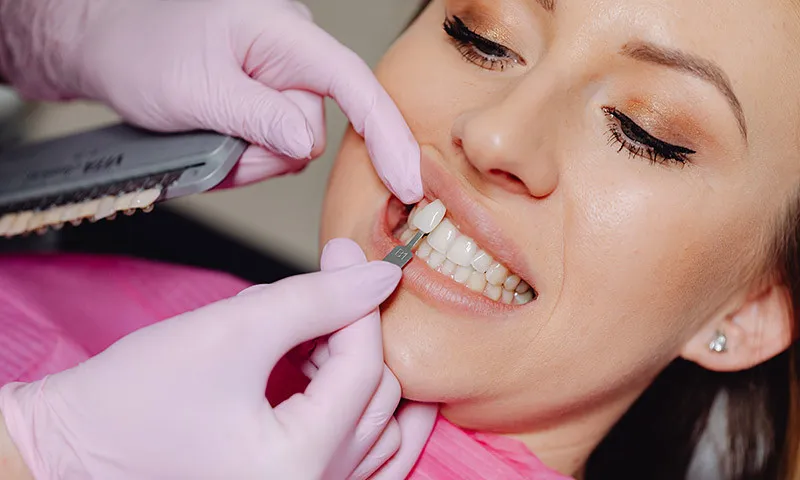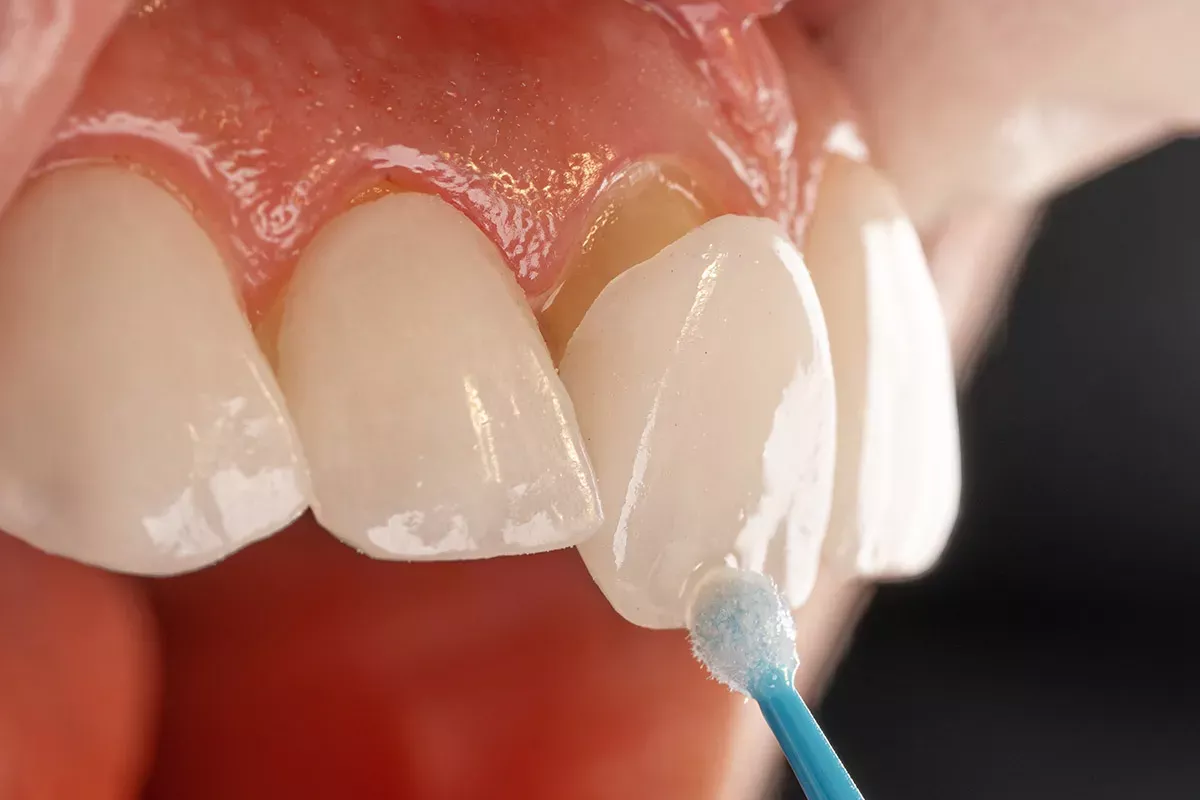The most important facts in brief
- Definition: Veneers are thin ceramic or plastic plates that are bonded to the tooth.
- Reasons: The ceramic plates cover discolouration and slight misalignments and are therefore popular with people who want more beautiful teeth; however, veneers can also be medically useful - for example, if a tooth has broken.
- Types: A distinction is made between conventional custom-made veneers, thinner non-prep veneers, standardised veneers-to-go and composite veneers made directly in the mouth by the dentist.
- Procedure: The teeth are ground down. Before they are fitted with a temporary restoration, an impression is taken, which the dental technician uses to make the veneers. When the veneers are fitted, they are bonded to the tooth surface and hardened with blue light. Grinding is not necessary for all types of veneers.
- Advantages and disadvantages: Veneers offer an aesthetic result, but the grinding of the teeth is irreversible and harbours some risks (pain, inflammation, risk of caries).
- Costs: In Germany, a veneer (per tooth) costs between 250 and 900 euros - depending on the type of veneer.
- Durability: Veneers have a good durability and can last for over 20 years.
- Care: Veneers should be cared for in the same way as your normal teeth so that they last as long as possible.
Definition: What are veneers?
The English word "veneers" (pronounced like "weniers") means something like veneering or panelling. Veneers are very thin shells made of ceramic or plastic, which are made by a dental technician and bonded to the tooth surface with a special adhesive. This allows discolouration, unevenness and slight misalignments to be concealed. As they are tooth-coloured, they are not noticeable in the mouth. They are mostly used on the front teeth. As veneers are bonded to a tooth, they are not dental prostheses.
What do veneers look like?
Patients have a say in how veneers look, as they can choose the colour and shape themselves. Patients also have the choice of having both the upper and lower jaw treated, or just the upper jaw, or leaving out the molars. You often see typical before-and-after pictures showing a snow-white smile, especially in veneer providers' adverts. However, veneers are also available for individual teeth and in shades that match the actual tooth colour.
When are veneers suitable?
Veneers are not only popular with Hollywood stars, but also with "normal" people who suffer from tooth discolouration and slight misalignments or gaps in their teeth and want more beautiful teeth. It is therefore often a purely cosmetic treatment. However, veneers can also be medically useful.
We have summarised the most common reasons for veneers here.
Aesthetic reasons:
- Tooth discolouration
- Crooked teeth (slightly misaligned teeth)
- Slight tooth gaps or uneven tooth spacing
- Teeth too short
- Grey teeth (for example after root canal treatment)
When are veneers medically necessary?
- Broken teeth and chipped corners
- Damage to the enamel on the front teeth
- Enamel malformations (e.g. uneven tooth surface)
- There are no guidelines as to the age at which veneers are suitable. In principle, veneers can be applied to people of all ages.
When are veneers unsuitable?
Veneers cannot compensate for larger misalignments or gaps between teeth. Braces are required for this. In addition, veneers are not suitable for the following people:
- People who grind their teeth
- People who bite their nails
- People who practise sports with an increased risk of dental injuries (e.g. martial arts or ball sports)
What types of veneers are there?
There are four different types of veneers in terms of material and production method:
- Conventional veneers
- Non-prep veneers
- Veneers-to-go
- Composite veneers
There are also so-called veneer splints. However, these are not really veneers, as they are not permanently attached to the teeth. Rather, they are a splint with straight, white teeth that can be inserted and removed from the mouth at any time. Veneer splints are not suitable for permanent wear in everyday life. Many people who use this type of splint have found that they cannot eat without restrictions - hard and chewy foods, for example, are taboo.
Let's take a closer look at the differences between the veneer types:
Conventional veneers
Conventional veneers are 0.5 to 1 millimetre thick and are made of ceramic. A dental technician produces them individually for each patient based on a dental impression. They can be matched exactly to the colour of the teeth and are correspondingly inconspicuous. At the patient's request, they can also be chosen in a lighter colour to lighten the teeth. To use conventional veneers, the teeth have to be ground down. Specifically, this means that the dentist removes around 0.3 to 1 millimetre of the tooth enamel, as the teeth would otherwise appear unnaturally thick. This process is irreversible.
Non-prep veneers
Non-prep veneers (also known as non-invasive veneers) are thinner than conventional veneers and can be applied directly to the tooth surface without prior grinding. They are also made of ceramic and are only around 0.2 to 0.6 millimetres thick. Another term that is often used in this context is "Lumineers". This is a brand of non-prep veneers from the USA. In contrast to conventional veneers, non-prep veneers can also be applied to crowns, plastic fillings or bridges.
As no tooth substance is removed with non-prep veneers, they are considered to be gentler than conventional veneers. However, the thin material also makes them more fragile and less durable.
Veneers-to-go
Unlike conventional and non-prep veneers, veneers-to-go are not customised. They are prefabricated ceramic sheets that are available in various colours, shapes and sizes. The dentist can bond them directly to the teeth without any waiting time, as there is no need for the dental technician to manufacture them. As there is no need for customisation, veneers-to-go are more cost-effective. However, the shapes and sizes are standardised and do not fit every tooth shape. They are therefore not suitable for every patient.
Composite veneers
Composite is actually a material that is often used for dental fillings. However, dentists can also mould veneers from it - directly in the mouth. To do this, the tooth surface is first slightly roughened. The dentist then applies the material to the tooth either using a mould or by hand. This allows him to change the shape and colour of the tooth. The success of this procedure depends on the skills of the dentist. In addition, plastic veneers are less stable than ceramic veneers. However, they can also be repaired more easily.
Procedure: How are veneers applied?
If you opt for veneers for medical or aesthetic reasons, you should definitely have the treatment carried out by a dentist and never attempt to make veneers yourself. We also advise against ordering online, as you should definitely seek advice from your dentist. After all, this is a procedure with long-term consequences. That's why you should only let a specialist do the work.
Veneers are inserted in four steps:
Investigation
The dentist will examine your teeth and check whether veneers are an option for you. You will then receive a cost estimate.
Good to know:
In the case of periodontitis and other dental diseases, it is important that the underlying disease is treated first and veneers are only used after successful treatment.
Preparation
The first step in preparation for veneers is a thorough tooth cleaning. With conventional veneers, the dentist grinds down around 0.3 to 1 millimetre of your teeth so that the teeth with veneers do not look too thick. This treatment step is also known as preparation. The dentist then makes an impression of the prepared teeth and provides the teeth with a temporary plastic restoration.
Manufacture
A dental technician fabricates the veneers by hand based on the impression. The patient has the choice of having the veneers made in the natural tooth colour or in a lighter shade. Patients can also decide on the tooth shape.
Inserting the veneers
After the dentist has checked whether the veneers fit, he cleans the teeth and dries them. The enamel is etched with an acid so that the veneers hold better. If the dentin, i.e. the layer under the enamel, is exposed, it is treated with a special dentin adhesive to ensure that the veneer holds well. The dentist then bonds the veneer to the tooth with a special adhesive and hardens the adhesive with a blue light lamp. Bonding the veneers takes about 20 to 30 minutes per tooth.
Advantages and disadvantages of veneers
If you are thinking about having veneers fitted, you should carefully weigh up the pros and cons. After all, the ceramic plates will remain in your mouth for decades. We have therefore summarised the advantages and disadvantages for you.
Advantages
According to the Society for Dental Health, Function and Aesthetics (GZFA), veneers are well suited to treating irreversibly damaged enamel or tooth defects caused by demineralisation. According to the German Society for Dental, Oral and Maxillofacial Medicine (DGZMK), only around 2 per cent of veneers are lost within the first six years. The durability is therefore good.
The following points are favourable for veneers:
- Aesthetically pleasing result
- Patients can choose their own tooth shape and colour
- Relatively long shelf life
- Short treatment duration (compared to orthodontic treatments)
Disadvantages: Are veneers harmful?
The biggest disadvantage of veneers is that the procedure is irreversible. This applies in particular to conventional veneers, where part of the tooth has to be ground down. Such a procedure should be carefully considered, especially for healthy teeth, so that you don't regret your decision later. Once the enamel has been removed, the procedure cannot be reversed. Tooth enamel does not grow back. So once you decide in favour of veneers, you will have to wear them for the rest of your life.
The removal of tooth enamel harbours certain risks: On the one hand, grinding down the teeth can make them particularly sensitive to pain and react with sharp pains to hot, cold, sweet and sour foods. On the other hand, there is a risk of bacteria colonising between the tooth and the veneer if the ceramic plates have not been placed correctly. This makes it easy for caries bacteria to penetrate the inside of the tooth unhindered - especially because the protective enamel layer is significantly thinner than that of a normal tooth. The tooth nerve can also be damaged during grinding, which can lead to chronic inflammation. If old fillings are removed during preparation, there is also a risk of the tooth breaking.
This is why we do not recommend veneers for healthy teeth, but only for teeth that are damaged anyway and need to be ground down.
Here is an overview of all the disadvantages:
- Unnecessary risk from grinding down a healthy tooth
- Possible pain in teeth
- Increased risk of caries with careless insertion
- High costs and not covered by health insurance (except in medically necessary cases)
- Risk of tooth fracture during grinding
- Discolouration of the veneers possible in case of leakage
- Chronic pulp inflammation possible
Comparison of alternatives to veneers
Depending on the reason why you are interested in veneers, there are various alternatives.
Veneers or crowns?
If your tooth is already damaged and you have the choice between a veneer or crown restoration, veneers are the gentler choice. Compared to a conventional crown, the dentist has to grind down significantly less tooth structure with veneers. The treatment is therefore more comfortable and less time-consuming. This applies, for example, to caries damage or teeth that have been damaged by a fall. In this case, the statutory health insurance fund pays the same amount as it would for a partial crown.
However, veneers are not suitable for severely damaged teeth.
Good to know:
You can find out exactly what a crown is and how it is used in our article:
Veneers or bleaching?
If you simply want a radiant white smile but actually have healthy teeth, we strongly advise against veneers. You will permanently damage your teeth by grinding them down and expose them to an increased risk of dental disease.
Bleaching is much gentler. The dentist does not grind down the teeth, but applies a bleaching gel containing hydrogen peroxide or carbamide peroxide to the teeth, which is activated with UV light. However, the bleaching gel also attacks the tooth enamel and can lead to sensitive teeth in the meantime. Important: If you want to have your teeth whitened, you should definitely have it done by a dentist and stay away from whitening products from the drugstore. On the one hand, the dose of these products is usually not high enough to achieve a really good result and on the other hand, irregularities can easily occur.
You can find out what alternatives there are to bleaching in our article:
Good to know:
The use of whitening toothpastes is even gentler than bleaching. However, you should make sure to choose a toothpaste without aggressive ingredients. Natural whitening toothpastes include 'Black is white' toothpaste or 'Be you' toothpaste from Curaprox.
Orthodontic treatment or veneers?
Veneers can only compensate for slight misalignments and gaps between teeth. For more significant misalignments, orthodontic treatment with braces is necessary. Aligners - invisible plastic braces - are an interesting alternative for adults with malocclusions. Although correcting misalignments with braces or aligners is considerably more time-consuming than inserting veneers, it is the better choice for dental health.
Costs of veneers
The cost of a veneer varies depending on the type of veneer. You can expect the following costs per tooth for treatment in Germany:
- Conventional veneers: approx. 500 to 800 euros per tooth
- Non-prep veneers: approx. 600 to 900 euros per tooth
- Veneers-to-go: approx. 350 to 400 euros per tooth
- Composite veneers: approx. 250 to 400 euros per tooth
Veneers-to-go are significantly cheaper because they are not customised. Composite veneers are less durable than ceramic veneers.
How much your veneers will cost depends, of course, on how many teeth you want to cover with veneers. It is common, for example, to apply veneers to the front teeth from canine to canine - either in the upper jaw only or in both the upper and lower jaw. The front molars can also be fitted with veneers. Veneers are usually not used on the back molars, which are not visible.
Important: If the veneers are a purely cosmetic treatment, statutory health insurance companies will not cover the costs - so you will have to pay for the treatment yourself. If there is a medical necessity, you can submit an application for cost coverage, which will be reviewed individually by the health insurance company. If they come to the conclusion that a cheaper crown is a sufficient repair, you can also use the fixed subsidy for the crown to insert a veneer and pay the difference yourself.
With supplementary dental insurance and private health insurance, it depends on the respective contract. As veneers are often paid for privately, many providers offer payment by instalments.
Costs of veneers abroad
As veneers are expensive in German-speaking countries and have to be paid for cosmetically, there is a lot of dental tourism to other countries where the costs are significantly lower.
The costs for veneers are lowest in Turkey. Veneers are up to 60 per cent cheaper there than in Germany. However, the costs in Hungary, Poland, the Czech Republic and Slovakia are also significantly lower than the prices in Germany or Switzerland.
Durability: How long do veneers last?
The University of Innsbruck carried out a long-term study on the durability of conventional ceramic veneers and came to the conclusion that they will still be intact after 10 years with a probability of 93.5 per cent and will still be undamaged after 20 years with a probability of 82.93 per cent.
The following durability estimates apply to the other three types of veneers:
- Non-prep veneers: five to ten years
- Veneers-to-go: about ten years
- Composite veneers: about 15 years
The duration of the guarantee and warranty for the veneers varies depending on the manufacturer and practice or clinic. Five years is common, for example.
How often do veneers need to be renewed?
If the veneers have been placed carefully and you take very good care of your teeth, conventional veneers do not actually need to be replaced and can last for over 20 years.
A veneer must be removed and replaced if it has been damaged and can no longer be repaired, or if caries has formed in the marginal area and the tooth under the veneer is diseased. In this case, the ceramic shell must be ground down, which also means that tooth substance is lost again.
Composite veneers do not last as long as ceramic veneers and are more susceptible to discolouration. However, they can be easily repaired in the mouth or removed and replaced without damaging the tooth.
How do I care for my veneers?
Proper oral hygiene has a major influence on the durability of veneers: the better you look after them, the longer they will last.
Regular check-ups & professional teeth cleaning
Go to the dentist regularly to have your teeth and veneers checked to prevent cavities from forming around the edges and veneers from having to be removed due to dental disease. You can prevent discolouration by having your teeth professionally cleaned on a regular basis. Although ceramic veneers themselves do not discolour, the edge area can take on a different colour over time.
Thorough oral hygiene
You should look after your veneers with exactly the same care as your normal teeth so that the teeth underneath remain as healthy as possible.
This includes:
- Brush your teeth twice a day - in the morning after breakfast and in the evening before going to bed for about three minutes with a soft toothbrush
- Clean the interdental spaces daily with an interdental brush
- Use fluoride toothpaste to protect against tooth decay - for example the 'Be you' range from Curaprox
- Clean the tongue daily with a tongue scraper
You can find out exactly which technique is best for your dental care routine in our instructions:
Instructions: Brush your teeth properly
Instructions: Clean interdental spaces properly
Instructions: Using a tongue scraper correctly
Instructions: Brushing your teeth properly with an electric toothbrush
Good to know:
Did you know that your teeth don't like it hard and rough at all, but prefer to be brushed gently? Our super-soft CS 5460 toothbrush is gentle on your gums and removes plaque much more thoroughly. It has around ten times as many bristles as a conventional toothbrush.
Sources
Dentlounge: The perfect smile with veneers.
Joint practice Dr Jürgen Kollmann & Dr Claus Gasteyer: Veneers - Beautiful teeth without grinding and anaesthesia, at: zahnarzt-frankfurt-main.com.
Society for Dental Health Function and Aesthetics (GZFA): Veneers: ceramic veneers.
Hauser, Andrea: Veneers: costs, durability, advantages and disadvantages at a glance, at: muenchener-verein.de.
Infomedicine: Veneers.
Veneer-Vergleich.de: Veneers Turkey.
Consumer advice centre: Veneers - correction of slight tooth misalignments, on: kostenfalle-zahn.de.
Dentists Burgergut Steffisburg: Whiter teeth - with veneers or bleaching?
Zahnärztekammer Westfalen-Lippe: Dental veneers: When are they useful?
Dental practice in Lehel: Periodontology.
Lucerne Dental Clinic: Veneers.
All websites last accessed on 08.11.2023.
 Swiss premium oral care
Swiss premium oral care








